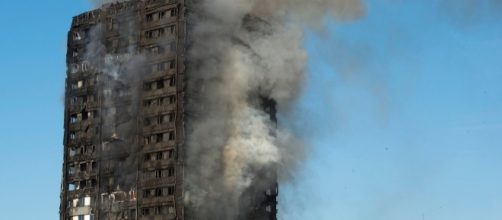The prior week has seen the origins of the Grenfell Tower's fire being disassembled with the Day of Rage march in London and calls for manslaughter charges by Metropolitan Police Detective Superintendent Fiona McCormack. However, the fundamental question amidst the politics of Grenfell irrevocably draws on the old question of class.
The tower situated close to Ladbroke Grove is among the 22 most deprived neighbourhoods in Kensington And Chelsea with a ranking of one or two out of 101 districts. The 2015 Indices of Deprivation report creates an IMD or Index of Multiple Deprivation Rank for every English neighbourhood by assessing variables such as income, employment, health deprivation and disability, crime, barriers to housing services and living environment.
In total, 53 neighbourhoods in Kensington and Chelsea have an IMD Rank of five and below out of the 32,844 Lower Layer Super Output Areas LSOAs (neighbourhoods) in England.
Subversively, 48 vicinities have a ranking of six and above with income and employment ranks falling into the highest decile of the 32,844 LSOAs, therefore, featuring some of the wealthiest areas of England. The economic contrast is something Grenfell Tower reifies with a short walk from the slum-ridden council estate along St Anns Road leading to the popular Westfield Shopping Centre, O2 Empire, Design Museum and Royal Crescent Gardens with housing prices topping over £4.3 million.
Dismissing working-class concerns
The deadliest fire since World War Two is undeniably a product of the council's prioritisation of investment into elite estates while subjugating and completely dismissing working-class concerns regarding unsafe social housing.
The Grenfell Action Group in November 2016 recorded their concerns about fire safety in a foreshadowing post Playing With Fire, asserting "only a catastrophic event will expose the ineptitude and incompetence of our landlord, the KCTMO...it is our conviction that a serious fire in a tower block" will be the "most likely reason those who wield power at the KCTMO (Kensington and Chelsea Tenant Management Organisation) will be found out and brought to justice."
There are no conspiracy theories surrounding the disaster; it has always been known as the question of when it would happen being imminent. Kensington and Chelsea council are paramount in assuming responsibility for the incident following their repeated dismissals and 'brushing away' of residents' concerns.
Nonetheless, the council has continued to be negligent in offering relief and accommodation for Grenfell's victims with assistance arriving via local communities and the spread of the news from social media. The public backlash to the slow, incompetent council response has forced Nicholas Holgate, the chief executive of Chelsea and Kensington council to resign last week in the presence of mounting pressure from Sajid Javid, the communities secretary.
Tory attitudes
In a Labour conference. Diane Abbott addressed the class issues pertaining to Grenfell declaring that it was "not just an accident" and "a direct consequence of Tory attitudes in social housing". The Labour MP drew on the controversial politics behind Britain's Right to Buy policy in her criticism of "outsourcing" and "deregulation" which subjugated working-class voices transforming them into "second-class citizens" with "second-class standards of safety".
The Thatcherite charcoal social housing dream Grenfell now symbolises, signifies a political impetus in the discussion of classism in Kensington and the entirety of British society. The Day of Rage march that coincided with the Queen's speech eschewed classist rhetoric in vehemently condemning Kensington's treatment of council house residents as 'corporate murder' and calling for Theresa May's resignation.
'Racist policies of this government'
Antonia Bright, a representative for the Movement for Justice (MFJ) organisation who scheduled the march, maintained, "We won't have business as usual. They will not carry on like nothing happened...We have lost people to the racist policies of this government."
The governmental silence has gradually been revoked with the City of London Corporation's purchase of 68 flats for £10 million to rehouse victims following Corbyn's request for the empty luxury estates to be handed to victims.
Nevertheless, on the conservative side, the response system has been beyond slow with Theresa May finally pledging a 'major national investigation' today into social housing, as cladding from 32 authorities across the country fail safety tests.
As further details of the tragedy unfold with the announcement of Grenfell's youngest victim, five-year-old Issac Paulos, who tragically choked on fumes from the fire, the West London fire has catastrophically highlighted the implications of archaic class segregation, hostility and deep economic divide in Britain's 'wealthiest' epicentres.
Opposition from upper-class residents
Although the new housing plan's proposal to shift homeless residents onto Kensington High Street signals a hopeful dismantlement of British classism, the clash of these two polarised Kensingtons is far from being quelled with opposition from upper-class residents.
A Kensington resident named only as Donna, recently called into the LBC radio station to declare they "would move" if the fire victims were to receive nearby property for free. The Guardian has recorded a likewise hostile response with Maria a property owner in a building, where apartments range from £1.5 million to £8.5 million, stating: "It’s so unfair. We paid a lot of money to live here, and we worked hard for it. Now, these people are going to come along, and they won’t even be paying the service charge!"
Ultimately, the dissolution of classist infrastructures and the 'council house' stigma that ignored the concerns of Grenfell's residents leaving them displaced in their own communities is now fundamental to generating the new politics of Post-Grenfell Tower.


